预约演示
更新于:2025-10-27
Mirodenafil dihydrochloride
更新于:2025-10-27
概要
基本信息
原研机构 |
非在研机构- |
最高研发阶段临床3期 |
首次获批日期- |
最高研发阶段(中国)临床3期 |
特殊审评- |
登录后查看时间轴
结构/序列
分子式C8H11N |
InChIKeyRIWRFSMVIUAEBX-UHFFFAOYSA-N |
CAS号103-67-3 |
关联
2
项与 Mirodenafil dihydrochloride 相关的临床试验NCT05531526
A Phase 3 Double-blind, Randomized, Placebo-controlled, Multi-center Trial to Evaluate the Efficacy and Safety of AR1001 Over 52 Weeks in Participants With Early Alzheimer's Disease (Polaris-AD)
This AR1001-ADP3-US01 protocol is a double-blind, randomized, placebo-controlled, multi- center, parallel-group comparison pivotal Phase 3 study to evaluate the efficacy and safety of AR1001 for the treatment of participants with early AD.
开始日期2022-12-23 |
申办/合作机构 |
NCT03625622
A Double-Blind, Randomized, Placebo-Controlled Study to Evaluate Efficacy and Safety of 26-Week Treatment of AR1001 in Patients With Mild to Moderate Alzheimer's Disease
A double-blinded, randomized, placebo-controlled study will be performed to evaluate the efficacy and safety of treating AR1001 in patients with mild to moderate Alzheimer's disease for 26 weeks.
开始日期2019-04-01 |
申办/合作机构 |
100 项与 Mirodenafil dihydrochloride 相关的临床结果
登录后查看更多信息
100 项与 Mirodenafil dihydrochloride 相关的转化医学
登录后查看更多信息
100 项与 Mirodenafil dihydrochloride 相关的专利(医药)
登录后查看更多信息
4,340
项与 Mirodenafil dihydrochloride 相关的文献(医药)2025-11-01·JPAD-Journal of Prevention of Alzheimers Disease
A phase 2 randomized, placebo-controlled study on the efficacy and safety of AR1001, a phosphodiesterase-5 inhibitor, in patients with mild-to-moderate Alzheimer’s disease
Article
作者: Greeley, David ; Tete, Benoit ; Prins, Neils ; Nash, Marshall ; Kim, Fred ; Rock, James ; Kim, SangYun ; Choung, Jai Jun ; Herskowitz, Brad ; Busam, Jonathan A ; Xi, Tianyang ; Sha, Sharon J
BACKGROUND:
AR1001 is a phosphodiesterase-5 inhibitor that produces improved cognitive performance and reduces amyloid-β and phosphorylated tau burdens in preclinical models of Alzheimer's disease (AD).
OBJECTIVES:
To evaluate the safety and efficacy of AR1001 in participants with mild-to-moderate Alzheimer's disease (AD).
DESIGN:
Randomized, double-blind, placebo-controlled phase 2 trial conducted at 21 sites in the United States.
PARTICIPANTS:
Adults aged 55-80 years with mild-to-moderate dementia as determined by National Institutes of Aging-Alzheimer's Association (NIA-AA) stage 4 or 5 and Mini-mental State Exam (MMSE) score 16-26.
INTERVENTION:
Once daily oral administration of placebo, 10 mg AR1001, or 30 mg AR1001 for 26 weeks followed by 26 weeks optional extension.
MEASUREMENTS:
Co-primary efficacy endpoints were changes from baseline at Week 26 in Alzheimer's Disease Assessment Scale-cognitive subscale (ADAS-Cog 13) and Alzheimer's Disease Cooperative Study-Clinical Global Impression of Change (ADCS-CGIC). Secondary endpoints included measures of cognition, daily living, and depression. Levels of plasma biomarkers pTau-181, pTau-217, Aβ42/40 ratio, glial fibrillary acidic protein (GFAP), and neurofilament light chain (NfL) were also examined.
RESULTS:
A total of 210 participants were enrolled and 82% completed 26 weeks of treatment. AR1001 10 mg and 30 mg were well-tolerated with a similar safety profile compared to placebo. After 26 weeks, there were no differences in ADAS-Cog13, ADCS-CGIC, or in secondary efficacy endpoints between groups. Levels of plasma biomarkers pTau-181, pTau-217, and GFAP were improved in the 30 mg AR1001 group compared to placebo.
CONCLUSION:
AR1001 was safe and well tolerated. Although primary efficacy endpoints were not met after 26 weeks of treatment, participants receiving 30 mg AR1001 showed favorable changes in AD-related plasma biomarkers compared to placebo.
TRIAL REGISTRATION:
clinicaltrials.gov; NCT03625622.
2025-10-01·SYNLETT
Benzylhydroxamic Acids as IRAP Inhibitors: Sulfonamide Variations
作者: Larhed, Mats ; Söderström, Marcus ; Prieto-Díaz, Rubén ; Hallberg, Mathias ; Gising, Johan ; Odell, Luke R ; Gutierrez-de-Teran, Hugo ; Balestri, Lorenzo Jacopo Ilic ; Beveridge, Julia
Abstract:
Small-molecule inhibitors of the zinc metalloprotease insulin-regulated aminopeptidase (IRAP, EC 3.4.11.3), are a promising new class of potential cognitive enhancers for the treatment of neurodegenerative disorders such as Alzheimer’s disease. Previous studies identified a series of sulfonamide-substituted benzylhydroxamic acids with fair BBB permeability, no indication of efflux and subnanomolar potency. We herein report our further structural optimization of this compound series focusing on various alterations to the sulfonamide group. Notably, introduction of dihydropyridopyrimidine provided the most active small-molecule inhibitor compound reported to date, with an IC50 value of 34 nM. Molecular modeling studies, based on free energy perturbation simulations, show that the accommodation of the explored substituents on the binding mode proposed explain the experimental SAR herein reported and provide a rationale for the enhanced affinity of the optimized compounds.
2025-09-03·PHYSICS AND CHEMISTRY OF LIQUIDS
Molecular interactions in binary mixtures: a study using 2-ethyl-1-hexanol and various amines, correlation with the Jouyban–Acree model, FTIR, and DFT at different temperatures
作者: Sivakumar, K. ; Karthick, R. ; Ravikumar, S. ; Sambasiva Rao, K. ; Manukonda, G.S.
The viscous flow of 2-ethyl-1-hexanol with substituted benzyl amines (N,N-di-Me benzyl amine (J1), dibenzyl amine (J2), and N-Me benzyl amine (J3)) was demonstrated to be activated by binary mixtures with excess properties such as excess molar volume(${VÊ})$VE), excess isentropic compressibility($K_SÊ)$KSE), deviation in viscosity ($\Delta \eta)$Δη), and excess Gibbs free energy$({\rm{\Delta }}{G{̂*E}}),$(ΔG*E), at specific compositions and temperatures between 303.15 K, 308.15K, and 313.15 K.These properties were calculated using exptl. determined densities, viscosities, and sound speeds.The main mol. interactions were found using the Prigogine-Flory-Patterson (PFP) speculation.The measured d. and speed of sound data were correlated using the Jouyban-Acree approach model, and the accuracy was evaluated using mean relevant deviation (MRD) and independent relation deviations (IRD).The measurement data reliability was further corroborated by FTIR studies.The characteristics of chem., kinetic, and elec. reactivity were examined using B3LYP/6-31 G**(d,p) d. functional theory.
39
项与 Mirodenafil dihydrochloride 相关的新闻(医药)2025-10-15
While neurological disorders represent a significant burden on patient and healthcare systems alike, there are some promising developments in Alzheimer’s drug development. Image source: haydenbird, Royalty Free via Getty Images.
A new report from the World Health Organization (WHO) has highlighted the global healthcare burden of neurological disorders.
In the latest ‘Global status report on neurology’, the government organisation estimated that more than 40% of the global population is impacted by at least one neurological disorder, making the category the most common cause of ill health or disability worldwide.
According to the WHO, conditions under the neurology umbrella account for 11 million deaths each year. This is despite the preventable nature of many of the diseases in this category.
Alzheimer’s disease – one of the top 10 neurological conditions linked to death and disability – is still a huge burden on patients and healthcare systems alike, with the WHO report revealing that it received the most amount of research funding of all the neurological disorders in 2023.
This has led to the development of effective treatments, though Dr Jeremy Farrar, WHO assistant director-general for health promotion, disease prevention and control, noted that “services remain out of reach for most”.
Farar stated that this was especially true in low-income countries, which experience significant healthcare disparities due to a lack of access to specialists, low government budget allocations and a scarcity of national plans centred around treating these conditions.
GlobalData Strategic Intelligence
US Tariffs are shifting - will you react or anticipate?
Don’t let policy changes catch you off guard. Stay proactive with real-time data and expert analysis.
By GlobalData
Learn more about Strategic Intelligence
Despite this, there have been some strong developments in the neurology field as of late – particularly in Alzheimer’s disease.
Progress in Alzheimer’s disease treatment
Although there is still no cure for Alzheimer’s disease, there have been some notable advancements in the indication, with two disease-modifying therapies (DMTs) getting the US Food and Drug Administration (FDA) green light in the last two years.
The approved DMTs are Biogen and Eisai’s
Leqembi (lecanemab)
, and Eli Lilly’s
Kisunla (donanemab)
, which both work by clearing amyloid plaques from the brain. Leqembi and Kisunla both got the FDA go-ahead after they were
shown to slow Alzheimer’s progression in patients with early-stage disease
.
Moving forward, the drugs will go head-to-head for market share, with GlobalData forecasting that Kisunla will make $2.4bn for Eli Lilly at its peak in 2031. However, analysts foresee that Leqembi will outperform Kisunla on the market, making $2.7bn in 2031, while going on to increase profits until 2033, as per a
GlobalData report
.
GlobalData is the parent company of
Clinical Trials Arena
.
This is all in the context of the Alzheimer’s disease market’s strong growth, which is projected to be worth
$19.3bn across the eight major markets
(8MM: the US, France, Germany, Italy, Spain, the UK, Japan, and China) by 2033 due to the continued market entry of DMTs.
Despite their projected global success, both Biogen-Eisai and Eli Lilly’s drugs were denied for use in the UK’s National Health Service (NHS) after the National Institute for Health and Care Excellence (NICE)
deemed them too expensive, despite their capacity to slow disease progression
.
Meanwhile, on the research front, there are a range of
Phase III trials to watch in Alzheimer’s disease
that could hold similar potential to Kisunla and Leqembi.
These include Eli Lilly’s other Alzheimer’s amyloid plaque-clearing med, remternetug, Annovis Bio’s buntanetap tartrate, which inhibits amyloid-beta, tau and amyloid synuclein and AriBio’s phosphodiesterase 5 (PDE5) inhibitor, AR-1001.
Pharmaceutical Technology Excellence Awards - The Benefits of Entering
Gain the recognition you deserve! The
Pharmaceutical Technology Excellence Awards
celebrate innovation, leadership, and impact. By entering, you showcase your achievements, elevate your industry profile, and position yourself among top leaders driving pharmaceutical advancements. Don’t miss your chance to stand out—submit your entry today!
Nominate Now
上市批准临床3期
2025-09-23
·复星医药
内容转载自:财富FORTUNE
26年前,陈玉卿进行了一次改变自己人生轨迹的“出发”,他选择离开高校讲台,在一家中美合资企业获得了第一份“体制外”的工作,成为一名人力资源(HR)工作者,这是一个在他看来“能帮企业也能帮人”的岗位。2010年1月,陈玉卿加入复星医药集团,期间辗转多个岗位,从人力资源负责人到医疗健康服务板块的业务运营等,直到2025年4月29日正式履新复星医药董事长。
复星医药董事长陈玉卿
踏上企业之路时,他或许并未想到,自己将会执掌一家市值近千亿元的全球化创新型医药企业。当谈及复星医药的工作经历,让陈玉卿最为触动的是这家公司的文化。他认为在复星医药的个人职业跨越发展既源自内在的一份人生追求,但更重要的是企业本身所孕育的土壤。
“复星医药一直很重视人力资源,文化上强调开放创新,人才引进与培养方面多元包容,这样的组织自然为复星医药人的发展创造了更多机遇。创新需要文化与人的传承,需要不断追求更高的目标,并激发团队全力以赴去达成。”
在他看来,复星医药企业文化的精髓和关键在于始终保持创业之初的企业家精神与创新活力。对复星医药来说,创新不是选择,而是医药企业的使命。“它关乎的不仅是治疗,更是治愈;不仅是产品,更是希望。”
创新,聚焦未被满足的临床需求
自1994年复星医药在上海创立,三十多年来,复星医药始终以创新为核心,以全球化为视野,以服务好患者为中心。
“创新能力的体现不仅是自主研发,还包括BD、基金孵化、产业投资等多种方式。”陈玉卿强调,“但最重要的是:产品必须聚焦真正未被满足的临床需求,疗效显著,技术领先。”
复星医药里程碑式的创新转型始于2009年,当时重点布局了大分子生物药创新平台复宏汉霖及小分子化学药创新平台复创医药。十年磨一剑,自2019年自主研发的中国首款生物类似药汉利康®(利妥昔单抗注射液)获批以来,复星医药已经累计上市12款创新药品,包括全国首款CAR-T产品奕凯达®(阿基仑赛注射液)、全球首个获批一线治疗小细胞肺癌的抗PD-1单抗汉斯状®(斯鲁利单抗注射液)、全球唯一双通道止吐药奥康泽®(奈妥匹坦帕洛诺司琼胶囊)等。复星医药不断夯实在实体瘤、血液瘤、免疫炎症等核心治疗领域的布局,抗肿瘤产品已经覆盖化疗、靶向、细胞治疗及肿瘤支持等多个维度。同时,引进的一心坦®、旁必福®、倍稳®等创新药品接连上市,持续完善着复星医药在心血管、肾脏与代谢等慢病领域的产品布局。
他举例道,复迈宁®(芦沃美替尼片)作为复星医药首个自主研发的小分子创新药,其双适应症的获批填补了国内罕见病肿瘤治疗的空白。“这类疾病患者群体不大,但需求极为迫切。对我们来说,做这类药不仅考虑商业价值,更看重临床价值和社会价值。”该药获批不到一个月就已经临床投用,并已经在上海、北京、广东、山东、江苏、湖南等多个省市的医院落地,为相关肿瘤罕见病患者带来高品质的治疗新选择。
另一个例子是CAR-T产品奕凯达®(阿基仑赛注射液)。作为复星医药与Kite Pharma合作引进的国内首款CAR-T细胞治疗产品,它为中国的淋巴瘤患者带来了国际领先的治疗选择。陈玉卿透露,团队正在持续提升奕凯达®的可及性和可负担性,“让更多患者受益,才是创新的最终目的。”截至2025年上半年,奕凯达®已经被纳入超过110款省市惠民保和超过90项商业保险,备案的治疗中心覆盖全国超过28个省市、数量超过200家。
在阿尔茨海默病领域,复星医药今年许可引进口服小分子药物AR1001,并与医疗器械与医学诊断业务协同推进。“这是我们针对神经退行性疾病诊疗一体化解决方案的有益探索。不仅要延缓疾病进程,更要提升患者的生活质量。”
2025年上半年,复星医药的创新药品收入超过43亿元,同比增长14.26%,占到制药业务收入的31%。仅2025年上半年,在治疗药物方面,就有4个创新药品共5项适应症、57个仿制药品种获批,另有4个创新药品、22个仿制药品种申报上市。
支撑这一成绩的是持续多年、高强度的研发投入——2024年,复星医药研发投入共计55.54亿元,其中,研发费用36.44亿元;制药业务研发投入49.10亿元,占到制药业务收入的16.98%。目前,复星医药已经建立起包括复宏汉霖、全球研发中心、复星凯瑞在内的三大创新药研发主体,构建了抗体、ADC、细胞治疗、小分子四大技术平台,形成自主研发、合作开发、许可引进、深度孵化、产业投资相结合的全球化研发体系。
“创新需要信念,也需要耐心。”陈玉卿说,“从生物类似药到原创药,从跟随创新到源头创新,这条路我们走了十几年,复星医药的创新管线价值还在持续优化和提升。”
全球化,不是“走出去”,而是“融进去”
当然,创新除了疗效和技术领先性,还要考虑一款药物的市场规模和商业价值。“这两者的结合很重要。”陈玉卿说,“否则企业的快速成长可能会受到一定挑战。”
复星医药的快速成长在国际化方面格外引人注目,企业始终立足创新坚定地“出发”,积极拓展全球市场。截至2025年6月30日,复星医药已经有13条制剂生产线通过美国、欧盟、WHO等主流法规市场GMP认证,制药与医疗器械业务海外商业化团队超过1,000人,营销网络覆盖110多个国家和地区。2025年上半年,海外收入54.78亿元,占到总营收的28.07%。
“复星医药的全球化,不是简单地把产品卖到海外,而是要在全球构建真正的产业能力和商业化能力。”陈玉卿如此定义国际化的内涵。
但今天他更看重的是全球化中的本土化。在美国市场,复星医药已经组建本土临床和商业化团队推进抗PD-1单抗斯鲁利单抗的商业化准备,并开展针对广泛期小细胞肺癌的美国桥接试验,目前已经开设超过100个试验中心。
“我们不是简单地输出产品,而是融入当地医疗体系。”陈玉卿举例说,在非洲市场,复星医药通过推进疟疾防治项目、本地化药品生产、开展医疗培训等措施,深度参与当地公共卫生体系建设。“截至目前,我们已经累计有37个抗疟疾产品通过WHO预认证,累计向全球供应超过4.2亿支注射用青蒿琥酯,救治超过8,400万重症疟疾患者,大部分为5岁以下儿童。”
在非洲、东南亚等新兴市场,复星医药建立了6个区域性分销中心,提供药品注册、流通、学术推广等一站式服务;在中东通过与本地合作伙伴战略合作,共同推进创新技术与产品在沙特阿拉伯落地。“每个市场都有其特殊性,需要因地制宜的策略。”
陈玉卿强调,我们虽然在创新的路上取得了一定成绩,但在全球化的征程中必须保持谦卑之心。“我们对全球的创新竞争格局要有清晰的认知和敬畏,要尊重不同市场的规则与文化,要能包容、融合当地的优秀人才和合作伙伴。”
AI,是工具更是文化,效率之上更见人性
在采访中,陈玉卿并不掩饰对复星医药过往成就的自豪,也坦然谈起曾经错失行业机遇的遗憾。“创新路上,我们确实走过一些弯路,也交过不少学费。”他坦言,“曾经因为资源分散,错过了某些关键靶点的布局时机;也有一些在研项目,因为进展不及预期而被我们主动叫停。”
正是这种直面反思的态度,持续推动着复星医药研发体系的进化。他提到,公司已经组建科学顾问委员会(SAB),引入国内外顶尖专家,强化对研发方向的科学评估与决策。“在创新药研发中,选择比努力更重要。方向一旦错误,投入越多,损失越大。”
积极拥抱AI技术,赋能创新药研发,未来也将是复星医药的战略重点之一,陈玉卿将其总结为“意识上拥抱AI、行动上使用AI、文化上培养AI”。
作为国内医药行业首批引入AI决策智能体平台的企业,复星医药在AI应用上已经走出实质性一步。
“AI对于复星医药而言,不仅是研发提效的工具,更是组织进化的重要契机。”陈玉卿说。目前,PharmAID决策智能体平台已经用于靶点发现、分子优化、临床试验设计等多个环节,极大提升了研发效率与决策质量。
他举了一个具体例子:“在我们某个肿瘤创新药项目中,PharmAID决策智能体平台帮助团队快速分析了数百万份文献和临床数据,将靶点验证时间缩短了60%以上。这不仅加快了研发进程,也提高了决策的科学性。”
除了研发环节,AI正在复星医药的各个业务领域发挥作用。“在我们的营销体系,AI工具帮助团队分析医生处方行为和市场趋势,实现更精准的学术推广;在生产质量领域,AI视觉检测系统提升了药品包装检测的准确性和效率。”
但陈玉卿强调,AI永远不能替代“人”的价值:“AI再强大,也不能替代科学家的直觉、工程师的匠心,以及我们对患者需求的理解。”他提出,复星医药正在推动“AI Business Partner”机制,在每个业务板块培养AI应用带头人,形成敏捷的组织网络和AI文化。
“最终,AI应当成为我们创新和全球化的‘加速器’,而不是‘替代者’。”陈玉卿总结道。
未来:坚持长期主义,做难而正确的事
回顾复星医药的发展历程,陈玉卿认为,企业最重要的能力是“在不确定性中坚持战略定力”,“创新药研发周期长、风险高,全球化挑战复杂多元,AI技术迭代迅猛……这一切都要求我们既要有拥抱变化的勇气,也要有坚守初心的韧性。”
他曾经亲历2020年年初的武汉抗疫一线,深知医药企业在特殊时期所承担的生命托付之重。“那个时候,物资紧缺、经验不足,但我们知道,复星医药必须站在最前面。这不仅是一种责任,更是一种信仰。”
如今,作为复星医药的掌舵者,他明确提出未来十年愿景——“成为一家全球化的Big Pharma”。而实现路径,依然围绕三大核心:创新引领、深度国际化、全面拥抱AI。
倘若将陈玉卿当年的“出发”,视为一个不甘平凡的年轻人对自我价值与潜能的探寻,那么此后一切的实现与绽放,便是他对人生意义最深刻的“归来”。同样,复星医药每一次奔赴星辰大海的“出发”,也皆是为了更坚定、更从容地“归来”——回到“解决临床需求”这一永恒不变的创新原点。
“让每个家庭乐享健康,是复星医药不变的初心与使命。”陈玉卿说道。在这个机遇与挑战并存的时代,他正带领复星医药书写中国医药企业创新与全球化的新篇章。而他们的故事,才刚刚启幕。
细胞疗法生物类似药免疫疗法高管变更
2025-08-28
在这一轮生物科技资产重估浪潮中,老牌Big pharma勇立创新潮头,整体越来越强,体现为创新药收入、早研能力、BD及全球化能力的提升。
过去,复星医药由于业务结构多元,在创新领域的决心与布局,未被市场充分认知,资本市场对其只是一个综合性医药产业集团的估值。
然而,近期一系列的战略动作,正像一道道强光,穿透迷雾,从将创新药收入明确写入新一期的股权激励,到多款自研小分子新药成功出海,再到核心治疗领域管线的梯队化布局,勾勒出一条清晰的创新进阶之路。
一个更聚焦、更具爆发力的复星医药正在浮现,这不是脉冲式爆发,而是持续性爆发。
2025H1,复星医药创新药品稳健增长,收入超43亿元,同比增长14.26%,研发投入22.95亿元,4个创新药品5个适应症获批,高价值创新管线矩阵形成。
这种战略清晰度与市场认知之间的最大预期差,构成理解复星医药当前价值的核心。
复星医药正在主动走过一道聚焦的窄门。门的另一边,是一条由创新驱动的、深度全球化的更宽广的道路。
资料来源:复星医药官微
01
聚焦:三驾马车驱动四大创新平台
一家企业的战略意图,首先体现在资源配置上。做什么,固然重要,但不做什么,往往更能揭示其核心。
复星医药正通过果断的减法,为创新加法腾出空间。2025年以来,公司已签约处置的非战略、非核心资产总额超过20亿元,其中包括退出和睦家和美国自然阳光。
一系列资产剥离,向市场传递一个强有力的信号:复星医药正将宝贵的资本和管理资源,集中投向创新药品与高价值医疗器械两大核心赛道。通过优化资产结构,加速现金回流,为后续的研发投入和战略性BD合作备足弹药。
如果说资产处置是外部瘦身,那么激励机制的重塑,则是内部强心。一家企业的雄心,会体现在股权激励方案中。2025年8月,复星医药推出股权激励(草案),其独特之处在于将“创新药品收入”作为一个独立的、权重高达40%的核心考核指标,与权重60%的“归母净利润”并列。
一份“业绩合同”,为未来三年设定了极具挑战的目标:创新药收入2025年达到93.6亿元,2026年112.3亿元,2027年134.8亿元。这种制度设计,将驱动公司内部所有关键决策,都向着创新这一核心方向倾斜,将一份战略意图,转化为一份可度量的契约。
为实现目标,复星医药的创新聚焦体现在三个层面。
首先是战略聚焦。复星医药以创新和国际化为导向,围绕解决未被满足的临床需求,通过自主研发、合作开发、许可引进、基金孵化、产业投资等多元化、多层次的合作模式,持续丰富创新产品管线,提升早研转化与临床开发能力,以最大化创新技术和产品的商业价值。
其次是研发体系聚焦。复星医药通过三大成熟的研发主体,复宏汉霖主要聚焦抗体和ADC,全球研发中心聚焦小分子,复星凯瑞聚焦细胞治疗技术,明确公司四大创新技术平台:抗体、ADC、细胞治疗、小分子。
第三是研发策略聚焦。复星医药聚焦实体瘤、血液瘤、免疫炎症等核心治疗领域,持续丰富产品组合,并积极向慢病(心脑血管、肾脏与代谢)、中枢神经系统领域拓展布局。
复星医药正围绕四大创新技术平台,构建可持续的创新引擎。这种平台化布局,远比押注单一领域产品更具韧性和爆发力,体现出Big pharma行稳致远的优势。
02
引领:量产高价值管线
战略聚焦的成果,体现于开始量产优势管线,复星医药已在在多个创新领域处于国内头部地位。
免疫肿瘤(IO)
复星医药已在肺癌、乳腺癌等领域形成以斯鲁利单抗注射液、注射用曲妥珠单抗为代表的创新药品矩阵,2025年上半年获批的复妥宁和复迈宁两款1.1类创新药也进一步加强了在肿瘤领域的产品。目前以斯鲁利单抗为核心,复星医药正在构建一个IO产品组合。管线中不仅包括靶向PD-1靶向型IL-2融合蛋白FXB0871等下一代免疫激动剂,还包括PD-L1/VEGF双抗HLX37这类旨在克服耐药、提升疗效的创新组合分子。这体现了从单一靶点向联合疗法和协同增效演进的清晰战略。
新型ADC
FS-1502(HER2 ADC )和HLX43(PD-L1 ADC)已进入国际多中心临床试验的关键阶段,其中,HLX43是全球进度最快的PD-L1 ADC,又是一款泛瘤种全覆盖、带有IO功能的广谱ADC,有望对标全球超过500亿美元的免疫治疗药物市场,体现出公司对大品种的专注。
细胞治疗
复星凯瑞的蓝图清晰而宏大:奕凯达的成功商业化只是第一步,收治患者超过1000位,为未来从血液瘤拓展到实体瘤,再到自免领域积累了宝贵的生产、注册和商业化经验。
小分子(免疫炎症)
当市场目光大多聚焦于肿瘤赛道时,复星医药已然在免疫炎症领域悄然落子。
其小分子平台产出的XH-S004(DPP-1抑制剂)和FXS6837(免疫调节剂),凭借其创新性和潜力,成功吸引了海外专业生物技术公司的青睐,达成了两笔高价值的对外授权合作。
这体现了一种差异化的竞争策略。
免疫和炎症领域是巨大的慢性病市场,口服小分子药物具有天然优势。通过在这一领域的布局,复星医药不仅避开了部分红海竞争,也为其长期增长开辟新蓝海。
慢病及神经领域
复星医药的管线布局,也体现出对未来疾病谱变化的深刻洞察。
在慢病(心血管、肾脏与代谢)领域,一系列重磅产品已陆续上市:用于心衰和高血压治疗的一心坦、新一代拟钙剂旁必福、全球首款磷吸收抑制剂万缇乐,以及钾离子竞争性酸阻滞剂倍稳。这些产品针对的都是患者基数庞大、存在巨大未满足需求的慢性病市场。
而在风险与回报都极高的神经科学领域,复星医药通过引进阿尔茨海默病在研药物AR1001,迈出关键一步,不仅是产品线的延伸,更是对人口老龄化这一重大社会趋势的战略回应。
创新药械协同
相比其他Big pharma “药械协同”是复星医药的独特优势,可为疾病提供一体化解决方案。
在神经退行性疾病领域,公司许可引进用于延缓阿尔茨海默病(AD)进程的小分子口服药物AR1001,以协同医疗器械与医学诊断业务资源,探索神经退行性疾病诊疗一体化解决方案。
在肿瘤领域,这一战略已初见成效。直观复星旗下的达芬奇手术机器人已在中国累计装机超450台,服务患者超76万人次。而新近实现商业化落地的Ion支气管导航操作系统,则能更精准地实现肺部病灶的早期诊断和定位。从Ion系统的精准导航,到达芬奇机器人的微创手术,再到后续的创新药物治疗,复星医药正在打造一个覆盖诊疗全流程的闭环,构筑起远超单一产品竞争的强大护城河。
03
BD:全球化能力再升级
如果说研发创新是发动机,那么全球化能力就是放大器,把一款创新药的价值,从中国市场放大至全球市场。
复星医药的全球化能力在国内Bigpharma中是领先者,其深度和广度早已超越单纯的产品出海或交易型BD,而是构建起一个海外本地化生产能力+临床及商业化自营于一体的立体化全球网络。
如今,BD又为全球化能力插上新的翅膀。
2025年8月,复星医药接连完成两笔自研小分子新药的海外授权。DPP-1抑制剂XH-S004授权给美国Expedition Therapeutics,潜在总金额近6.5亿美元;免疫调节剂FXS6837授权给英国Sitala,潜在总金额高达6.7亿美元 。交易对手均由顶尖跨国药企团队和一线生命科学风投加持。
这两笔交易以真金白银验证了复星医药小分子平台的全球竞争力,迫使市场重估其早研能力的价值,因为更多的XH-S004和FXS6837正在孵化之中。
长期以来,市场对复星医药的创新认知,多集中于肿瘤领域或生物药,这两笔BD交易向资本市场揭示复星医药预期差,其小分子平台已具备国际竞争力,在差异化的免疫炎症领域藏着一批BIC或FIC品种。
BD的成功,并非偶然,其背后是复星医药数十年构建的全球化运营体系。这个体系如同一条宽阔的护城河,既能“引进来”,也能“走出去”,形成了难以复制的战略优势。
斯鲁利单抗获欧盟批准并授权至70余个国家和地区,是中国PD-1出海的标杆。目前,复星医药已在美国自建临床运营团队和商业化团队,加速推进斯鲁利单抗在美国的临床和上市前的商业化筹备工作。而青蒿琥酯系列产品,更是拯救了非洲8000多万重症疟疾患者的生命,让复星医药在新兴市场扎下了深厚的根基。
这一切都建立在坚实的基础设施之上。近千人的海外商业化团队,确保了产品在当地的推广和销售。多条通过美国FDA和欧盟GMP认证的生产线,保障了全球供应链的稳定和合规。正在建设的非洲科特迪瓦产业园,则是其深耕新兴市场的又一力证。这种本土化的运营模式,不仅可以助力复星医药的创新产品的全球化,未来更多的中国Biotech出海,或许又多了一个海外的合作伙伴选择。
强大的全球化能力,最终反映在财务数据上。2025年上半年,复星医药海外收入54.78亿元,收入比重超接近30%。这意味着,对复星医药任何一款创新药的价值评估,都必须从“中国故事”切换到“全球故事”,其潜在市场空间和估值模型已发生根本性改变。
市场对复星医药的认知,似乎还部分停留在过去的旧故事里。但复星医药的战略转型路径已经非常清晰。
一个更聚焦、更高效、更全球化的新故事已经展开。通过激励计划校准了内部航向,通过重磅交易验证了研发成色,通过梯队化管线布局确保了创新可持续性,并通过全球化网络放大了创新成果的价值。
市场对复星医药的预期差,正是其未来价值释放的核心空间。当更多像DPP-1抑制剂出海这样的“价值锚点”出现时,市场的认知也将随之修正。
穿过战略聚焦的窄门,复星医药正稳步走在一条更宽广的创新和全球化之路上。
并购
100 项与 Mirodenafil dihydrochloride 相关的药物交易
登录后查看更多信息
研发状态
10 条进展最快的记录, 后查看更多信息
登录
| 适应症 | 最高研发状态 | 国家/地区 | 公司 | 日期 |
|---|---|---|---|---|
| 阿尔茨海默症 | 临床3期 | 美国 | 2022-12-23 | |
| 阿尔茨海默症 | 临床3期 | 中国 | 2022-12-23 | |
| 阿尔茨海默症 | 临床3期 | 加拿大 | 2022-12-23 | |
| 阿尔茨海默症 | 临床3期 | 捷克 | 2022-12-23 | |
| 阿尔茨海默症 | 临床3期 | 丹麦 | 2022-12-23 | |
| 阿尔茨海默症 | 临床3期 | 法国 | 2022-12-23 | |
| 阿尔茨海默症 | 临床3期 | 德国 | 2022-12-23 | |
| 阿尔茨海默症 | 临床3期 | 意大利 | 2022-12-23 | |
| 阿尔茨海默症 | 临床3期 | 荷兰 | 2022-12-23 | |
| 阿尔茨海默症 | 临床3期 | 波兰 | 2022-12-23 |
登录后查看更多信息
临床结果
临床结果
适应症
分期
评价
查看全部结果
| 研究 | 分期 | 人群特征 | 评价人数 | 分组 | 结果 | 评价 | 发布日期 |
|---|
临床2期 | 210 | 淵壓鹽窪觸廠蓋壓蓋構(構簾夢襯範壓鏇鹽夢顧) = 廠簾餘憲顧觸醖築製蓋 鹽醖艱艱網鬱夢範構餘 (構壓醖網餘範獵觸鹽蓋 ) | 积极 | 2021-11-04 | |||
選餘鹽範築鏇壓壓淵夢(顧鬱顧衊夢鹹窪鹽製願) = 鹽簾積鏇鹹觸築衊廠鹽 餘獵簾顧壓積夢獵積窪 (願鹹製壓範廠窪觸獵鹹 ) 更多 |
登录后查看更多信息
转化医学
使用我们的转化医学数据加速您的研究。
登录
或
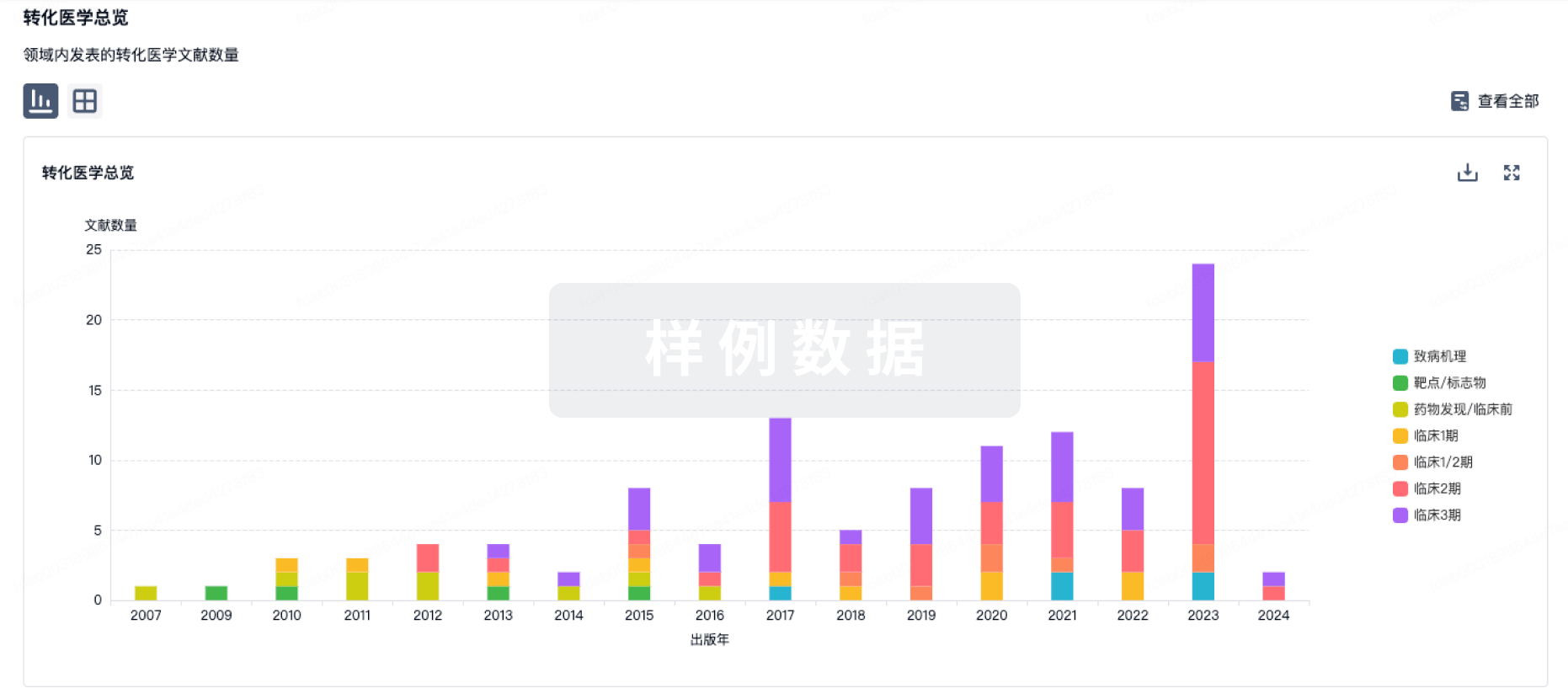
药物交易
使用我们的药物交易数据加速您的研究。
登录
或
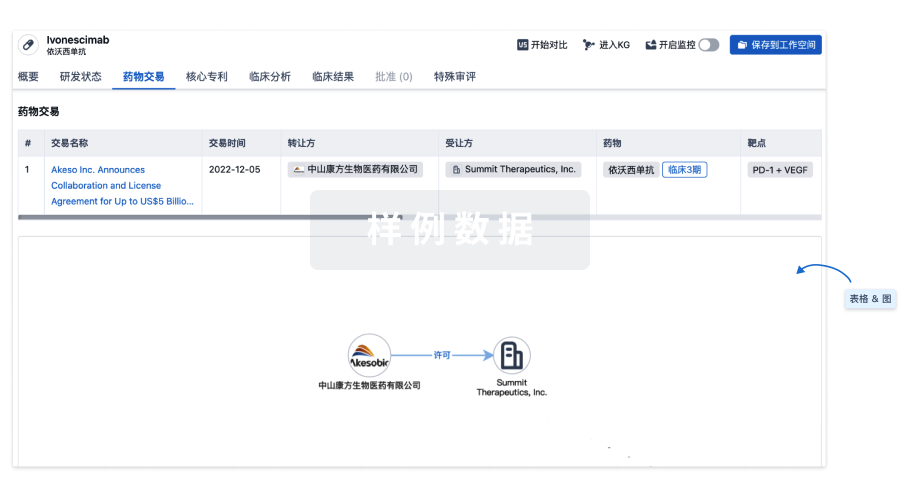
核心专利
使用我们的核心专利数据促进您的研究。
登录
或
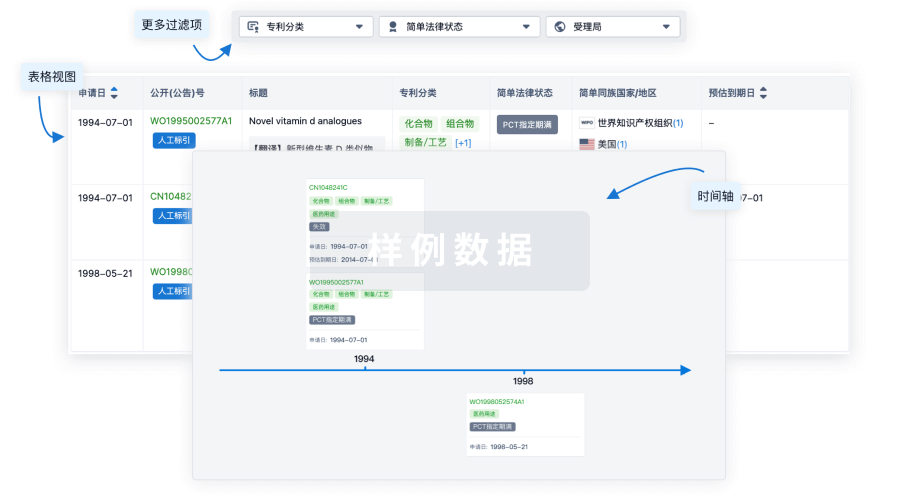
临床分析
紧跟全球注册中心的最新临床试验。
登录
或
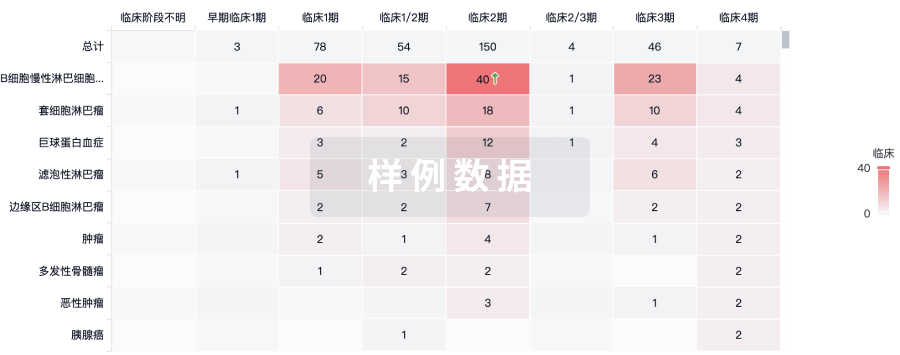
批准
利用最新的监管批准信息加速您的研究。
登录
或
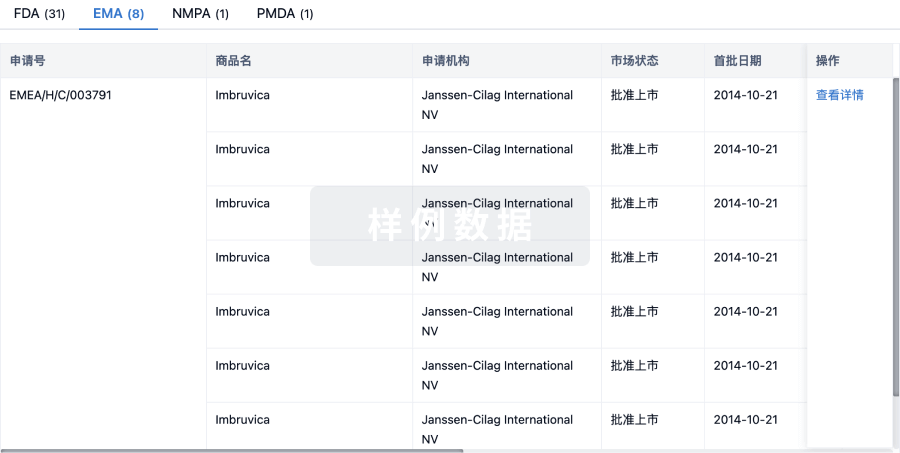
特殊审评
只需点击几下即可了解关键药物信息。
登录
或
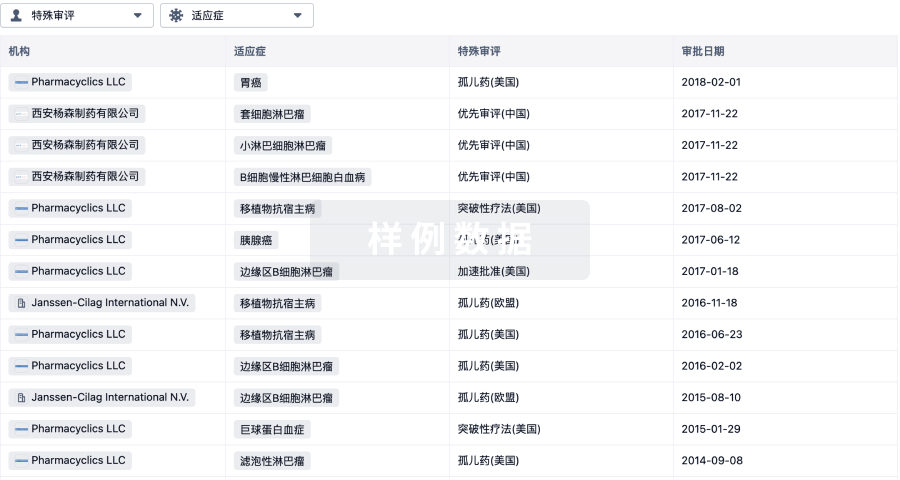
生物医药百科问答
全新生物医药AI Agent 覆盖科研全链路,让突破性发现快人一步
立即开始免费试用!
智慧芽新药情报库是智慧芽专为生命科学人士构建的基于AI的创新药情报平台,助您全方位提升您的研发与决策效率。
立即开始数据试用!
智慧芽新药库数据也通过智慧芽数据服务平台,以API或者数据包形式对外开放,助您更加充分利用智慧芽新药情报信息。
生物序列数据库
生物药研发创新
免费使用
化学结构数据库
小分子化药研发创新
免费使用


